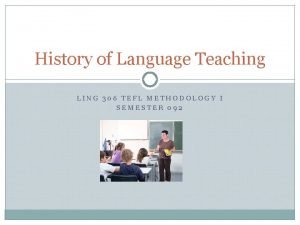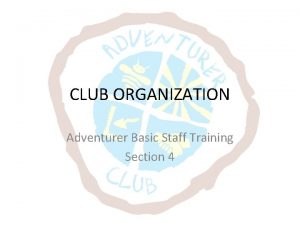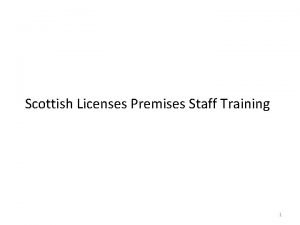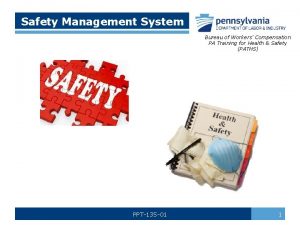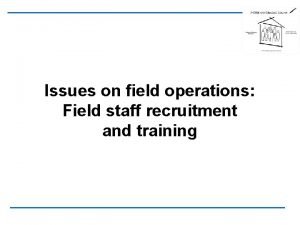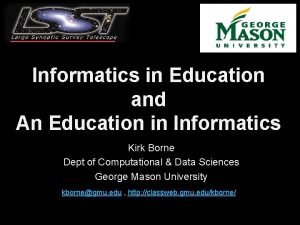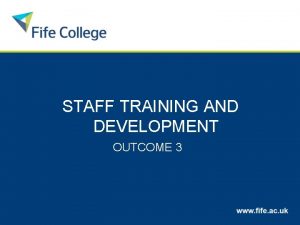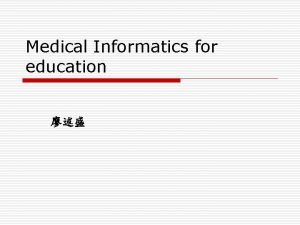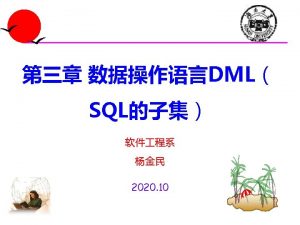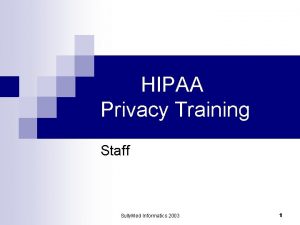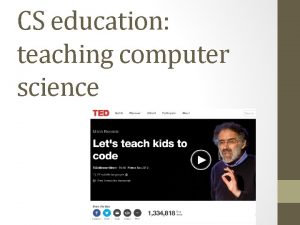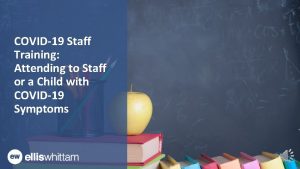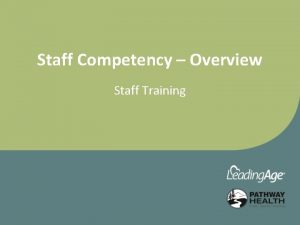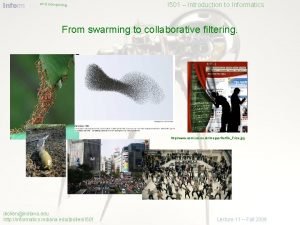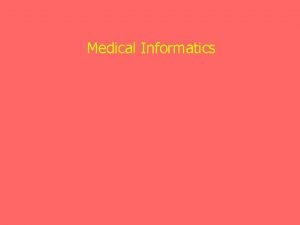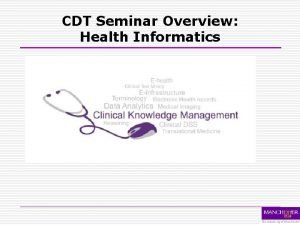Training methodology for education of informatics teaching staff
























- Slides: 24

Training methodology for education of informatics teaching staff in primary and secondary schools Leonid Stoimenov, FEEN Dragan Gejo, RSD

Overview • Background – IT and Education • Facts from Regional School Directorate • Teaching methodology • Conclusion

Background • Information Tecnologies (IT) – are the means that give us a challenge and ample opportunity for social development. – Especially a great challenge for Serbia • Informatics is important part of infrastructure for modern public economy and society development in Serbia*. • The role of IT in education and development will be the central topic in next few years in Serbia*. *according to “Strategy of economic development of Serbia until 2010” given by Serbian government (Ministry of Science Technologies and Development, Belgrade, 2002, authors: group of experts, Edited by Vlastimir Matejic

IT and Education • Rapid changes in informatics need continuous education of teaching staff in primary and secondary schools. • Serbian Ministry of Education and Sports, notes that “…the changes in global economic environment, the needs of economy, technology and development trends demands adequate educated individuals. ”* *Serbian Ministry of Education and Sports, draft document, “Development of politics and strategies for professional education”, 2005 • The same document points out that …”transformation of educational process are an important assumption for the future society and economic development of Serbia”. • Promptness of education of new and existing teaching staff is crucial.

Informatics Education in Serbia • Education in informatics in primary and secondary schools is not at adequate level: – bad equipment and accessibility of computers for the purposes of education, and – low computer literacy of school-teachers. • Serbia is deficient in educated teaching staff for informatics. • The necessity of teacher’s further education has arisen also. – absence of permanent and continuous education of teaching staff in primary and secondary schools* *According to draft document of Serbian Ministry of Education and Sports “Development of politics and strategies for professional education”

Facts from Regional School Directorate (RSD) Niš • RSD covers main cities in Central Serbia (Niš, Prokuplje, Pirot). • There are: – 122 schools • 78 primary and • 44 secondary schools – 299 Informatics teachers • 197 or 66% are in primary schools, and • 102 of them or 34% are in secondary schools.

Facts from RSD – age structure • More than 40% are older than 50, and • even 67% is older than 40. ØSuch age structure implies low level of teacher’s knowledge about new trends and technologies in informatics.

Facts from RSD – teachers education • More than 30% (exactly 98 teachers) don’t have higher education (VI degree according to the Serbian law) • Less than 27% (79 teachers) are educated at faculties probably with informatics in syllabus. – Tehre is not information about their diploma supplement, and – there is not exact information about number of teacher with higher education in informatics. • 40% of teaching staff have higher education inadequate for informatics teachers.

Facts from RSD – Informatics in schools • Informatics as an optional course in primary schools. • There are not syllabuses for informatics courses – an inadequate educated teacher decides what is important for teaching. • There are some results in syllabus definition for secondary schools – a new curriculum for subjects of education in informatics in secondary schools in 2002. – investment in raising awareness and computer literacy with usage of IT. – Government of Serbia, in next two years, is planning to equip 1600 primary and secondary schools with 30. 000 computers, Internet connection and appropriate software* *Serbian Ministry of Finance, National Investment Plan for 2006 -2011, Section “Education”, page 6, item 5. 1.

Training Methodology • Great diversity in education of teaching staff. • A lot of informatics teachers have no adequate professional background. • Younger teachers usually have better informatics education. • Most of current informatics teachers have to reinforce their knowledge. • Our training methodology will be focused on continuous education of Informatics teachers in primary and secondary schools in Serbia.

Training Methodology – blended technique • Schools teachers have obligations in their schools during the semester, and we can not organize intensive and frequent courses for them. • Our blended technique encloses: – – (1) phase of preparation for e-learning; (2) phase of distance learning (e-learning); (3) seminars; (4) and lab practices. • Each trainee passing all four phases.

Training process (1)

Training process (2)

Training process (3)

Prerequisites • We will establish a Center for Continuous Education at the FEEN. • The Center will facilitate e-learning, seminars and workshops with practical work. • We plan to provide continuous education using blended way of learning. • A system for e-learning will be established and the portal for teachers will be developed under the supervision of EU partners.

Seminar on E-learning Selection of Informatics teachers from RSD 120 teachers Seminar on E-learning 1 day

E-learning courses • We will develop courses for informatics teachers • Aim is to innovate their knowledge and make them competent for new technologies. • Teachers should be educated to use modern information technologies and apply them in teaching process • In order to do that we will establish Web based platform for e-learning as a basis for life-long learning.

E-learning courses (cont. ) 120 teachers Computer Architectures and Networks Modern Concepts in Programming Internet Technologies 120 teachers 3 months E-learning – 3 courses

Seminars • After the stage of e-learning • We plan to retrain 120 teachers • In the final stage we will organize – Workshops for small groups with accent on practical work, and – testing of candidates.

Seminars (cont. ) • Instructors from the FEEN will develop a proposal for teaching material and a set for lab practicing. • Work with teachers using blended technique. • Seminars for all teachers: – Computer Architectures and Networks – Modern Concepts in Programming – Internet Technologies • Our plan is to provide materials for all seminar participants • After each seminar, there a distance training, workshop and exam.

Seminars – details • 120 trainees/teachers, • 6 groups, 20 trainee per seminar • 200 working hours: 2 months per trainee, 6 hours per day

Formal Recognition 120 retrained informatics teachers • The pilot program will be carried out with Ministry of Education and Sports for all schools under the RSD Nis. • Seminars and course materials will be accredited by Serbian Ministry of Education and Sports. • We plan to provide certificates for all candidates passing final test. • Certificates will be authorized by FEEN, and approved by Serbian Ministry of Education and Sports.

Conclusion – overview of the methodology • Schools teachers have obligations in their schools during the semester, and we can not organize intensive and frequent courses for them. • Because of that, our blended technique encloses: – – (1) phase of preparation for e-learning; (2) phase of distance learning (e-learning); (3) seminars; and (4) lab practices. • Each trainee passing all four phases. • 120 trainee, 20 per group • 200 working hours: 2 months per trainee, 6 hours per day • The quotient of e-learning in educational process is about 50%.

Comments, suggestions, ideas?
 History of language teaching methodology
History of language teaching methodology Trade show booth staff training
Trade show booth staff training Adventurers club uniform
Adventurers club uniform Personal boundaries examples
Personal boundaries examples Event staff training
Event staff training Licensed premises staff training
Licensed premises staff training Unsafe
Unsafe Training plan for employees
Training plan for employees Safety training for housekeeping staff ppt
Safety training for housekeeping staff ppt What is pathfindering
What is pathfindering Field staff training
Field staff training Methodology of environmental education
Methodology of environmental education Importance of theatre
Importance of theatre Micro teaching meaning
Micro teaching meaning Kontinuitetshantering
Kontinuitetshantering Typiska drag för en novell
Typiska drag för en novell Tack för att ni lyssnade bild
Tack för att ni lyssnade bild Vad står k.r.å.k.a.n för
Vad står k.r.å.k.a.n för Varför kallas perioden 1918-1939 för mellankrigstiden
Varför kallas perioden 1918-1939 för mellankrigstiden En lathund för arbete med kontinuitetshantering
En lathund för arbete med kontinuitetshantering Underlag för särskild löneskatt på pensionskostnader
Underlag för särskild löneskatt på pensionskostnader Tidböcker
Tidböcker Sura för anatom
Sura för anatom Vad är densitet
Vad är densitet Datorkunskap för nybörjare
Datorkunskap för nybörjare
